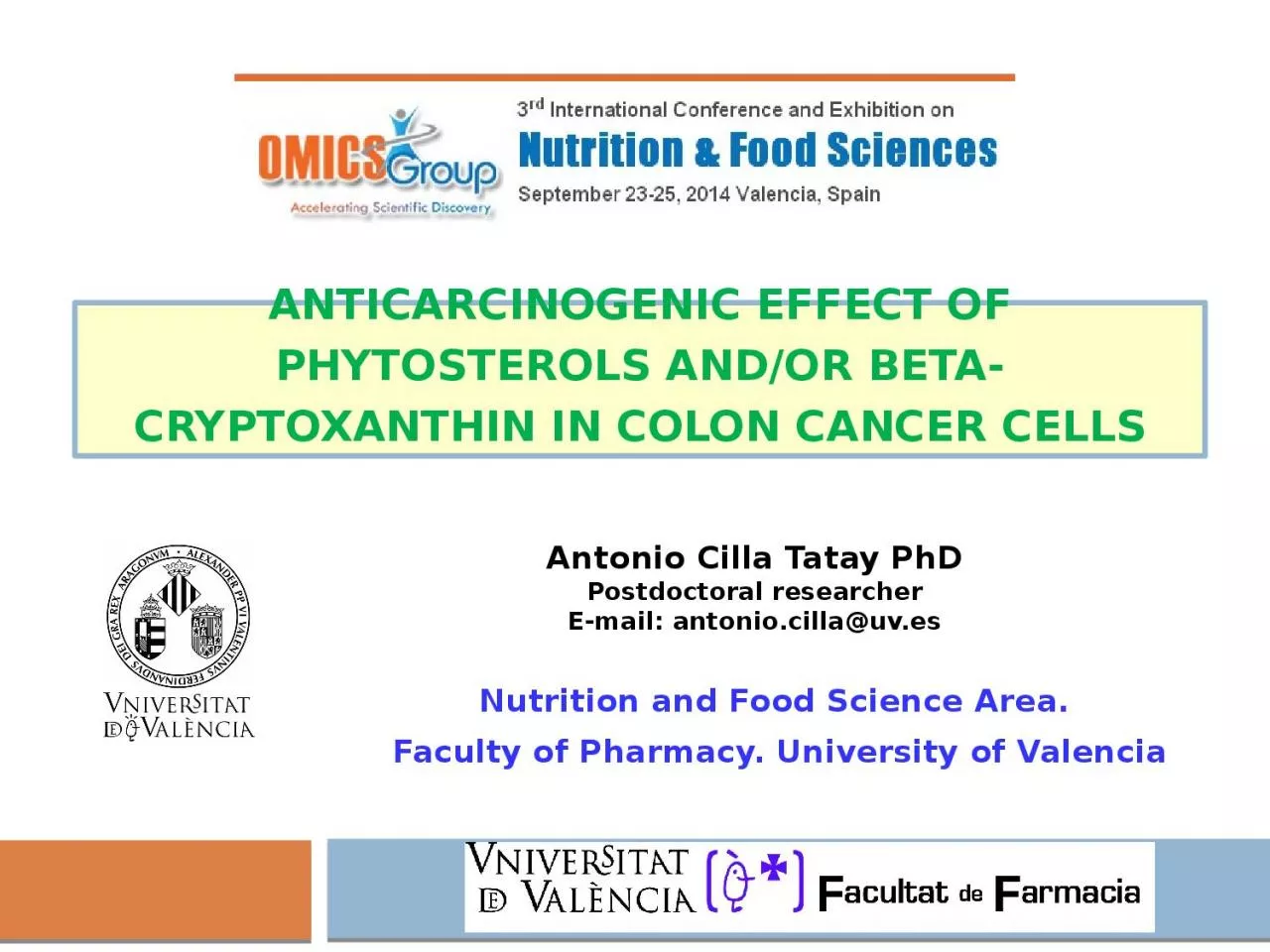

Science Area Faculty of Pharmacy University of Valencia ANTICARCINOGENIC EFFECT OF PHYTOSTEROLS ANDOR BETACRYPTOXANTHIN IN COLON CANCER CELLS Antonio Cilla Tatay PhD Postdoctoral ID: 935946
Download Presentation The PPT/PDF document "I Nutrition and Food" is the property of its rightful owner. Permission is granted to download and print the materials on this web site for personal, non-commercial use only, and to display it on your personal computer provided you do not modify the materials and that you retain all copyright notices contained in the materials. By downloading content from our website, you accept the terms of this agreement.
Slide1
I
Nutrition
and
Food Science Area. Faculty of Pharmacy. University of Valencia
ANTICARCINOGENIC EFFECT OF PHYTOSTEROLS AND/OR BETA-CRYPTOXANTHIN IN COLON CANCER CELLS
Antonio Cilla Tatay PhDPostdoctoral researcherE-mail: antonio.cilla@uv.es
Slide2BACKGROUNDDETERMINANTS OF HEALTHLalonde (1974)
Slide3BACKGROUNDBygbjerg, I.C. Science (2012) 337: 1499-1501Yach et al. JAMA (2004) 291: 2616-2622
Slide4BACKGROUNDColorectal cancer incidence rates by sexDeveloped countriesDeveloping countriesCenter et al. CA Cancer J Clin (2009)59:366–378
Slide5BACKGROUNDAetiology of colon cancer Colorectal cancer is widely believed to be an enviromental diseaseCultureSocial statusLifestyle practicesDietary habits Heredity
ALCOHOL
SMOKING
HYPERCALORIC FOODSCHEMICALS
HEALTHY DIET
PHYSICAL ACTIVITY
Slide6BACKGROUNDNormal epitheliumEarly adenomaIntermediate adenomaCarcinomaLate adenomaSteps and evolution of colon cancerTransformation (initiation)Promotion (tumoral growing)Invasion (distant metastasis)
Manson
, M.M.
Trends Mol. Med. (2003) 9: 11-18Chemoprevention by phytochemicals
Slide7BACKGROUNDFunctional food trends in 2014http://www.foodmag.com.au/news/naturally-functional-foods-to-lead-the-way-in-2014
Slide8BACKGROUNDFunctional foodsClassicalFiber & carbohydratesBioactiveVitaminsMineralsAminoacidsProbioticsCereals-glucansSoyResistant starchInulinFruit fiberPhytosterolsCarotenoidsPolyphenolsAntioxidant extracts (cocoa, grape seed)ω-3 and ω-6
β
-
sitosterol , campesterol and stigmasterol β-cryptoxanthinSaura-Calixto et al.,
(2005)
Slide9BACKGROUNDWHY THESE COMPOUNDS?Gastrointestinal and systemic effects of a doubly modified functional beverage containing β-cryptoxanthin and phytosterols; unravelling potential mechanisms and mediators.National Research Project (AGL2012-39503-C02-01)
β-cryptoxanthin
beneficial properties in different bone remodeling markers (formation and
resorption
)
Phytosterols
hypocholesterolemic
effect
Combined
action
against
colon
cancer
?
Slide10BACKGROUND
Proposed
mechanisms
of
action
of phytosterols and carotenoids on carcinogenesisTanaka et al. Molecules (2012) 17: 3202-3242Woyengo, et al. Eur. J. Clin. Nutr
. (2009) 63: 813-820
Slide11OBJECTIVES1. Evaluate the antiproliferative activity of main dietary phytosterols and/or β-cryptoxanthin against a colon cancer cell line (Caco-2 cells). 2. Unravel the biochemical and molecular mechanisms involved in their possible antiproliferative activity.
Slide12SAMPLES AND METHODSSAMPLESStandards (alone or in combination) at phyisiological human serum concentrations according to: Cilla et al., Ann Nutr. Metab. (2011) 58, suppl 3, 104 Granado-Lorencio et al., J. Agric. Food Chem. (
2011) 59, 11819-24
METHODS
β-cryptoxanthinβ-sitosterolCampesterolStigmasterol
Caco-2
cellsCell treatment(
continuous incubation 24 h with phytochemical standards) Cell viability - MTT test (Spectrophotometry) Cell cycle (Flow cytometry) Apoptosis Annexin V (Flow cytometry) Mitochondrial membrane potential (Flow cytometry) Intracellular Ca2+ (Flow cytometry) Reactive oxygen species ROS (Flow cytometry) Total thiols
(
Spectrophotometry
)
Pro-
apoptotic
BAD
protein
(Western
blot
)
PARP-1 / caspase-3
susbtrate
(Western
blot
)
Slide13RESULTSDifferent letters denote statistical significant differences (p<0.05) using one-way ANOVA followed by LSD post-hoc test.acdefbcgdefg
cdefg
g
fg
efg
cde
cdefgcdefbcdA) IMPACT ON VIABILITY AND APOPTOSIS
Slide14RESULTSA) IMPACT ON VIABILITY AND APOPTOSISAn asterisk indicates statistically significant diferences (p<0.05) versus control using one-way ANOVA followed by LSD post-hoc test******Cell cycle distribution
Slide15RESULTSA) IMPACT ON VIABILITY AND APOPTOSISControlβ-CX+PS mixPS mixStig
(0.25 µM)
Camp (1 µM)
β-sit (12µM)β-CX (3 µM)
PI
PI
PIPIPIPIPIAnnexin VAnnexin VAnnexin VAnnexin VAnnexin VAnnexin VAnnexin VApoptosis (Annexin V)
Slide16RESULTSA) IMPACT ON VIABILITY AND APOPTOSISAn asterisk indicates statistically significant diferences (p<0.05) versus control using one-way ANOVA followed by LSD post-hoc test*****Changes in mitochondrial membrane potential (MMP)
Slide17RESULTSA) IMPACT ON VIABILITY AND APOPTOSISControlStig (0.25 µM)PS mixβ-CX + PS mixCamp (1 µM)β-CX (3 µM)β-sit (12 µM)PARP (116KDa)Cleaved product (89KDa)Actinabcddd
b
Poly
(ADP-ribose)polymerase (PARP) cleavage
Slide18RESULTSB) REDOX STATEControlβ-CX+PS mixPS mixStig (0.25 µM)Camp (1 µM)
β
-sit (12µM)
β-CX (3 µM)Reactive oxygen species (ROS)
Slide19RESULTSB) REDOX STATEDifferent letters (a-e) denote statistical significant differences (p<0.05) using one-way ANOVA followed by LSD post-hoc test.abccdbcdedeTotal thiols (-SH)
Slide20RESULTSC) Ca2+ AND RELATED SIGNALLING PATHWAYSCytosolic calcium influxDifferent letters (a-e) indicate statistically significant diferences (p<0.05) versus control using one-way ANOVA followed by LSD post-hoc testbcbccddeaab
Slide21RESULTSC) Ca2+ AND RELATED SIGNALLING PATHWAYSControlStig(0.25 µM)PS mixβ-CX + PS mixCamp(1 µM)β-CX(3 µM)
β
-
sit(12 µM)p-BAD(Ser 136)
Actin
a
bccdbcdPro-apoptotic BAD dephosphorilation
Slide22RESULTSAdapted from Vejux et al., Braz. J. Med. Biol. Res. (2008) 41, 545-556β-cryptoxanthin / β-sitosterol Campesterol / Stigmasterol Externalization of
phosphatidylserine
Rise
in cell cycle sub-G1
OVERVIEW
Slide23CONCLUSIONS β-cryptoxanthin and/or main dietary phytosterols (alone and in combination) reduced cell growth of colon cancer Caco-2 cells up to 44% due to apoptosis, possibly through the mitochondrial pathway No clear dose-response was observed, neither additive nor synergistic effect for mixtures, but they retain the
same antiproliferative
activity
as individual compounds indicating absence of antagonistic actions The effects were obtained
with concentrations compatible with
physiological serum levels in humans and with reported bioavailability
of these phytochemicals after regular consumption of a beverage containing a mix of all these molecules
Slide24FUTURE RESEARCHFunctional beverages containing phytosterols and β-cryptoxanthinColon cancer (Caco-2 cells) In vitro gastrointestinal digestion In vitro colonic fermentationAnti-proliferative activity
Slide25ACKNOWLEDGEMENTSBionutest research group. University of ValenciaLaboratory of Biochemistry (STEBICEF).University of Palermo Dr. Reyes Barberá Dr. María Jesús Lagarda Dr. Amparo Alegría Dr. Guadalupe García- Llatas Lorena Claumarchirant PhD student Dr. Maria Antonia Livrea Dr. Luisa Tesoriere Dr. Alessandro Attanzio Dr. Mario Allegra
Slide26Thank you for your attention